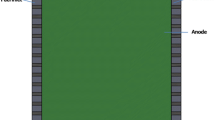Summary
A model of the gas flow in airways during an instantaneous outburst of coal and gas is formulated and solved numerically using MacCormack's explicit finite-difference scheme. This model is based on the assumption that geological structures, in-situ stresses and high-gas-pressure gradients play important roles in initiating an outburst, with the gas content and gas-pressure gradients being the most dominant factors. The fluid-dynamic processes that occur after an outburst are computed by the numerical integration of the complete time-dependent Navier-Stokes equations. The mixture velocity, the density and the gas-concentration profiles in both time and space domains (immediately after an outburst) are presented. The global results are useful in gaining an improved understanding of gas-flow patterns during coal/gas outbursts and in determining the range of the disturbance so that effective methods of control can be developed.
Similar content being viewed by others
Abbreviations
- a :
-
speed of sound
- C :
-
gas concentration (mass)
- C v :
-
specific heat at constant volume
- C p :
-
specific heat at constant pressure
- CFL:
-
Courant-Friedrichs-Lewy number
- E :
-
total energy of the mixture
- F :
-
the vector defined in Equation 27
- G :
-
the vector defined in Equation 28
- h :
-
entropy
- h i :
-
entropy at inlet
- J xi :
-
diffusion flux in the i-direction
- k :
-
thermal conductivity of a gas
- M :
-
Mach number
- P :
-
pressure of a mixture (the partial pressure of gas)
- P :
-
gas pressure
- P a :
-
atmospheric pressure
References
Adrian, B. (1985) Convection Heat Transfer, John Wiley, New York.
Briggs, H. (1920) Characteristics of outbursts of gas in mines, Trans. Instn. Min. Engrs., 61, 119–146.
Buckingham, C., Taylor, K.N.R. and Paul, G.L. (1984) Novel remote sensing gas outburst detector, Aust. J. Coal Min. Technol. Res., pp. 50–8.
Campoli, A.A. et al. (1985) Coal and gas outbursts: prediction and prevention, Coal Mining, 42–7.
Coeuillet, R. (1959) Present knowledge of sudden outbursts of gas, Annls Mines Carbw., Paris, pp. 233–249.
Ettinger, I.L. (1982) Use of the iodine index for outburst forecasting, Ugol Ukr, 28 pp.
Farmer, I.W. and Pooley, F.D. (1977) A hypothesis to explain the occurrence of outbursts in coal based on a study of West Wales outburst coal, Int. J. Rock Mech. Min. Sci. Geomech. Abstr., 4, 189–198.
Hargraves, A.J. (1980) Keynote address: a review of instantaneous outburst data. The Symposium on the Occurrence, Prediction and Control of Outbursts in Coal Mines, pp. 1–18.
Huang, G.P. (1987) The computation of elliptic turbulent flows with second moment closure models, PhD thesis, University of Manchester, UK.
Janas, H. (1979) Improved method for assessing the risk of gas/coal outbursts, Sec. Int. Mine Vent. Cong., Reno, NV.
Kidybinski, A. (1981) Bursting liability indices of coal, Int. J. Rock Mech. Min. Sci. Geomech. Abstr., 18, 295–304.
Lama, R.D. (1981) Use of adsorption/desorption isotherms in predicting outburst conditions, CSIRO Division of Applied Geomechanics, Australia, Report GCM21, 76 pp.
Lama, R.D. and Mitchell, G.W. (1981) Investigations on geomechanical parameters in relation to outbursts of gas and coal at Leichhardt Colliery, CSIRO Division of Applied Geomechanics, Australia, Report BCM9, 49 pp.
Litwiniszyn, J. (1985) A model for the initiation of coal-gas outburst, Int. J. Rock Mech. Min. Sci. Geomech. Abstr., 22, 39–46.
Litwiniszyn, J. (1990) Rarefaction shock waves, outbursts and consequential coal damage, Int. J. Rock Mech. Min. Sci. Geomech. Abstr., 27, 535–40.
MacCormack, R.W. and Baldwin, B.S. (1975) A numerical method for solving the Navier-Stokes equations with applications to shock boundary layer intersections. AIAA paper 75-1, 13th AIAA Aerospace Meeting, Pasadena, CA, USA.
Mandella, M. (1987) Experimental and analytical studies of compressible vortices, PhD thesis, Department of Applied Physics, Stanford University, Stanford, CA.
Onopchuk, B.N. (1976) Mechanism of rock fracture in gas bursts, Soviet Min. Sci., 12, 198–201.
Sheng, J. and Otuonye, F.O. (1988) A model of gas flow during an outburst, Proceedings of the Fourth International Ventilation Congress, Brisbane, Queensland, Australia, Vol. 1, pp. 191–197.
Shepherd, J., Blackwood, R.L. and Rixon, L.K. (1984) Instantaneous outbursts of coal and gas with reference to geological structures and lateral stresses in collieries, The South African Institute of Mining and Metallurgy, Symposium Series No. 6, pp. 97–106.
Author information
Authors and Affiliations
Rights and permissions
About this article
Cite this article
Otuonye, F., Sheng, J. A numerical simulation of gas flow during coal/gas outbursts. Geotech Geol Eng 12, 15–34 (1994). https://doi.org/10.1007/BF00425934
Received:
Issue Date:
DOI: https://doi.org/10.1007/BF00425934




